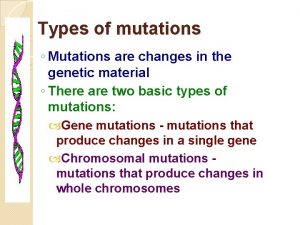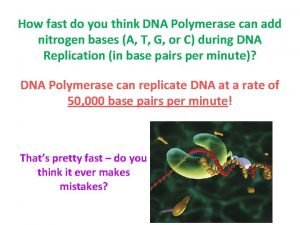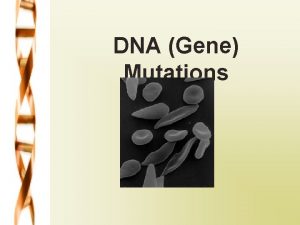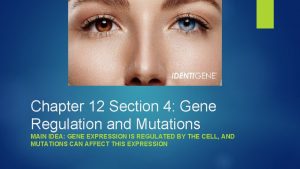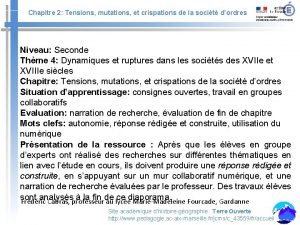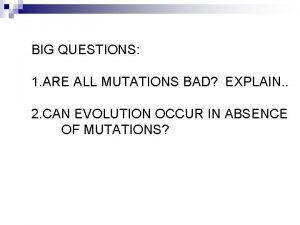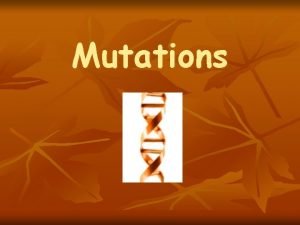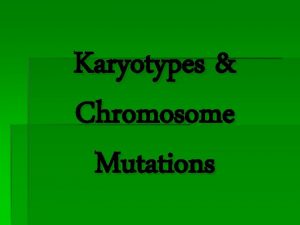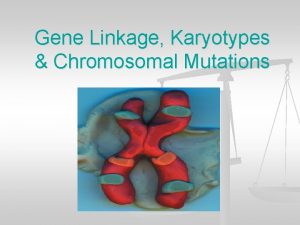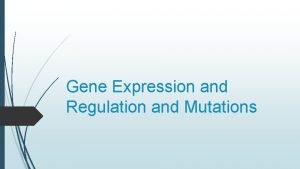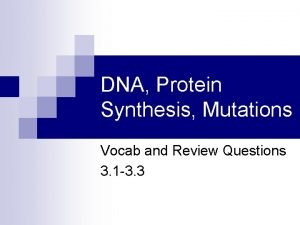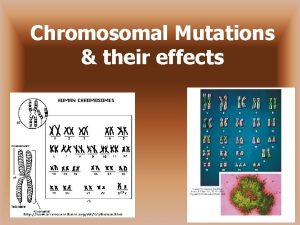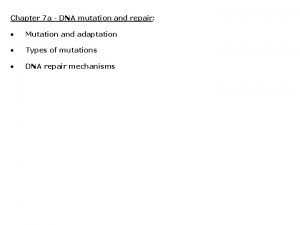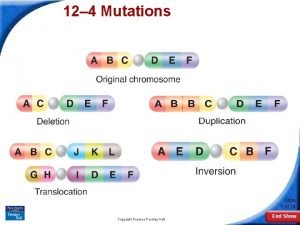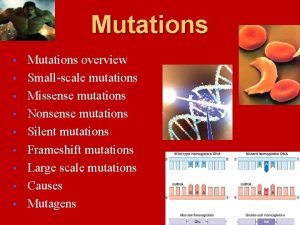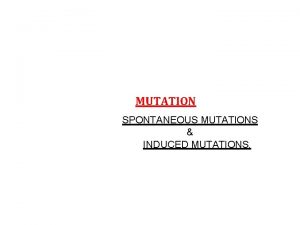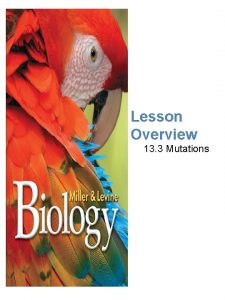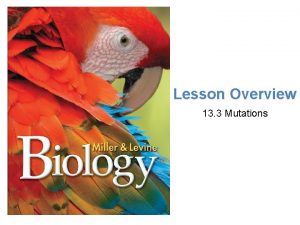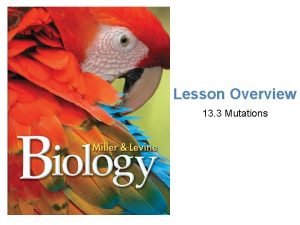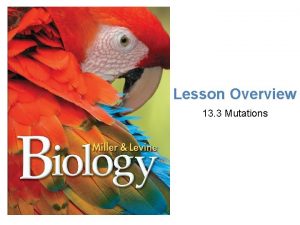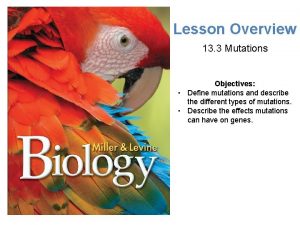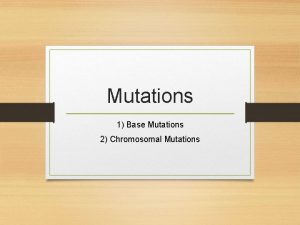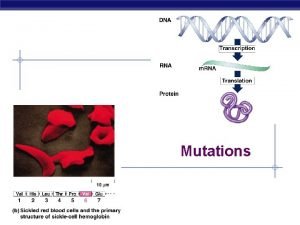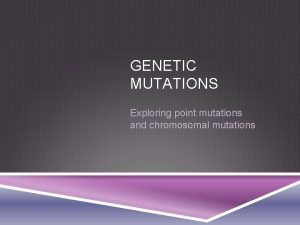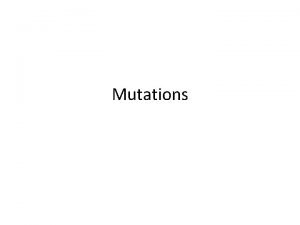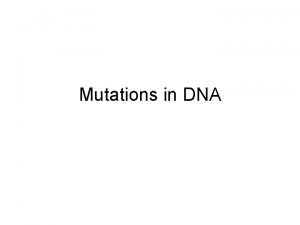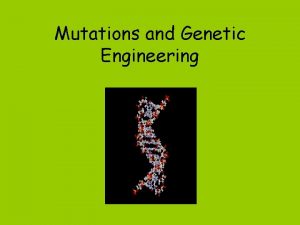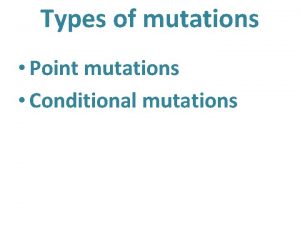Lesson Overview Mutations Lesson Overview 13 3 Mutations

















- Slides: 17

Lesson Overview Mutations Lesson Overview 13. 3 Mutations

Lesson Overview Mutations Types of Mutations Now and then cells make mistakes in copying their own DNA, inserting the wrong base or even skipping a base as a strand is put together. These variations are called mutations, from the Latin word mutare, meaning “to change. ” Mutations are heritable changes in genetic information.

Lesson Overview Mutations Types of Mutations All mutations fall into two basic categories: Those that produce changes in a single gene are known as gene mutations. Those that produce changes in whole chromosomes are known as chromosomal mutations.

Lesson Overview Mutations Gene Mutations that involve changes in one or a few nucleotides are known as point mutations. If a gene in one cell is altered, the alteration can be passed on to every cell that develops from the original one.

Lesson Overview Mutations Gene Mutations Point mutations include substitutions, insertions, and deletions.

Lesson Overview Mutations Substitutions In a substitution, one base is changed to a different base. Substitutions usually affect no more than a single amino acid, and sometimes they have no effect at all.

Lesson Overview Mutations Insertions and Deletions Insertions and deletions are point mutations in which one base is inserted or removed from the DNA sequence. These are called frameshift mutations because they shift the “reading frame” of the genetic message and can the protein so much that it won’t be functional.

Lesson Overview Mutations Chromosomal mutations involve changes in the number or structure of chromosomes. These mutations can change the location of genes on chromosomes and can even change the number of copies of some genes. There are four types of chromosomal mutations: deletion, duplication, inversion, and translocation.

Lesson Overview Mutations Chromosomal Mutations Deletion involves the loss of all or part of a chromosome.

Lesson Overview Mutations Chromosomal Mutations Duplication produces an extra copy of all or part of a chromosome.

Lesson Overview Mutations Chromosomal Mutations Inversion reverses the direction of parts of a chromosome.

Lesson Overview Mutations Chromosomal Mutations Translocation occurs when part of one chromosome breaks off and attaches to another.

Lesson Overview Mutations Effects of Mutations Genetic material can be altered by natural events or by artificial means. The resulting mutations may or may not affect an organism, most do not. Some mutations that affect individual organisms can also affect a species or even an entire ecosystem.

Lesson Overview Mutations Effects of Mutations Many mutations are produced by errors in genetic processes. The cellular machinery that replicates DNA inserts an incorrect base roughly once in every 10 million bases. Small changes in genes can gradually accumulate over time.

Lesson Overview Mutagens Mutations Some mutations arise from mutagens, chemical or physical agents in the environment. Chemical mutagens include certain pesticides, a few natural plant alkaloids, tobacco smoke, and environmental pollutants. Physical mutagens include some forms of electromagnetic radiation, such as X-rays and ultraviolet light. Stress can also be a factor.

Lesson Overview Mutations Harmful Effects Some of the most harmful mutations are those that dramatically change protein structure or gene activity. Example: Sickle Cell Disease

Lesson Overview Mutations Beneficial Effects Some of the variation produced by mutations can be highly advantageous to an organism or species. Example: Pesticide Resistance and Polyploidy
 Chapter 14 lesson 4 mutations
Chapter 14 lesson 4 mutations Syndrome triple x
Syndrome triple x What are some neutral mutations
What are some neutral mutations Cytoplasm structure
Cytoplasm structure What causes mutations
What causes mutations Chapter 12 section 4: gene regulation and mutations
Chapter 12 section 4: gene regulation and mutations Tensions mutations et crispations de la société d'ordres
Tensions mutations et crispations de la société d'ordres Are all mutations bad? explain.
Are all mutations bad? explain. A permanent change
A permanent change Protein synthesis and mutations
Protein synthesis and mutations Slidetodoc.com
Slidetodoc.com Chromosome mutation
Chromosome mutation Examples of chromosomal mutations
Examples of chromosomal mutations Protein synthesis and mutations
Protein synthesis and mutations Protein synthesis and mutations
Protein synthesis and mutations Chromosomal mutation
Chromosomal mutation Types of substitution mutations
Types of substitution mutations 12-4 mutations
12-4 mutations

